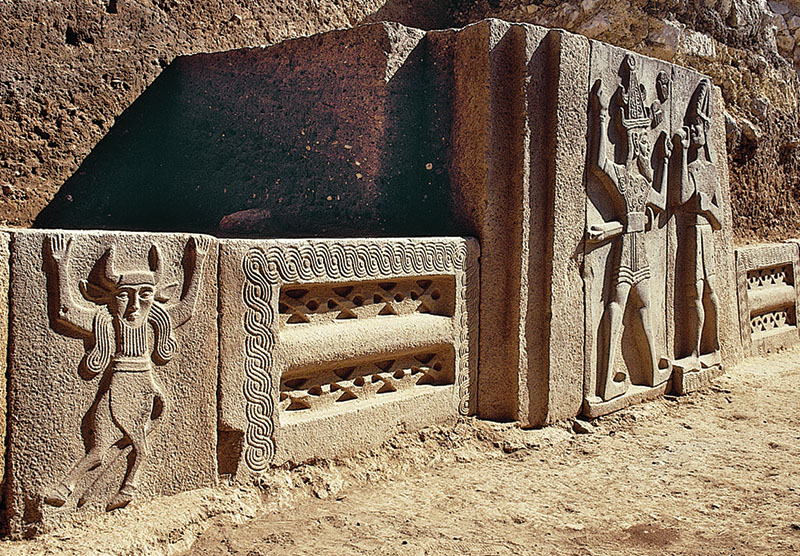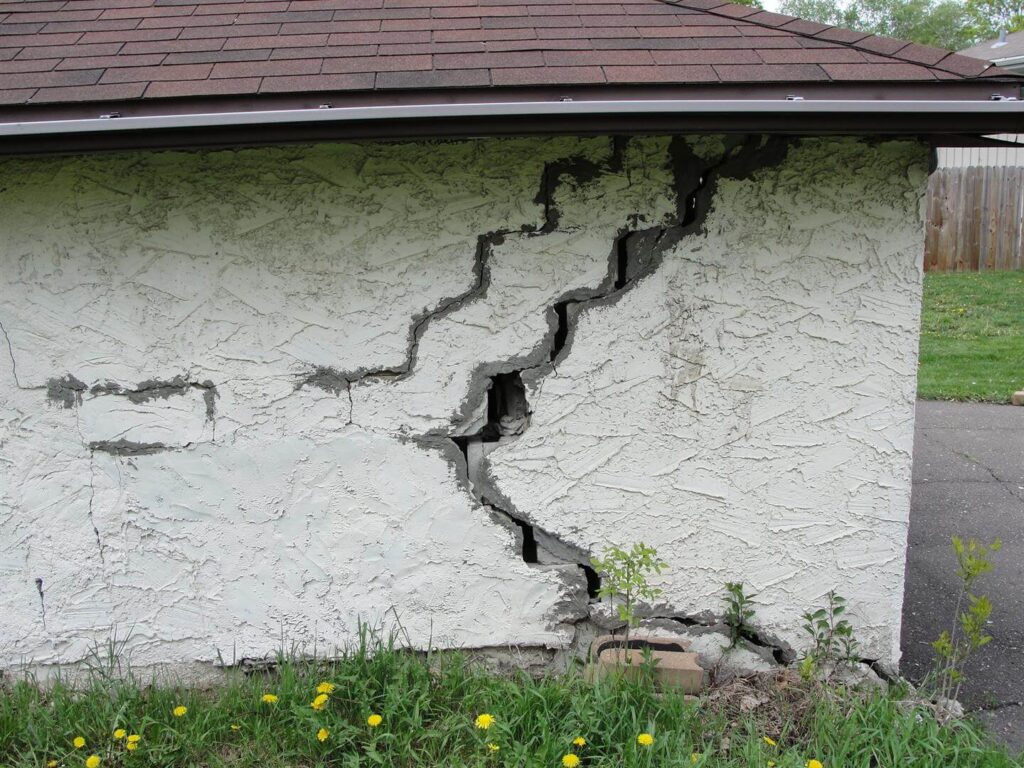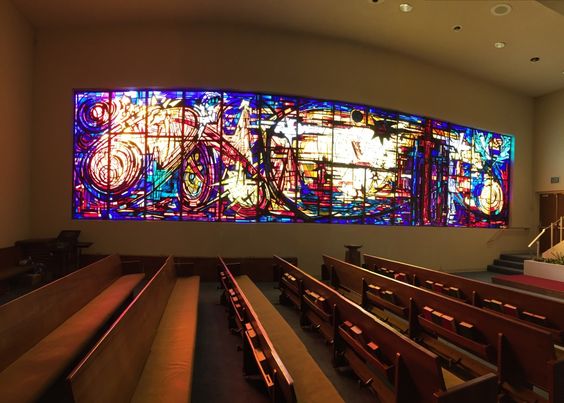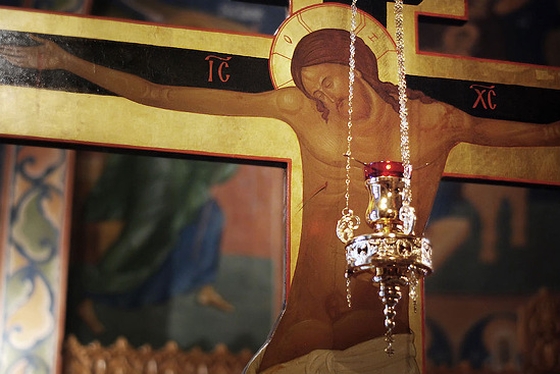Dominic Bnonn Tennant, a Reformed Baptist, raised some important questions about Reformed iconoclasm. In “Are Pictures of Jesus Idolatry?” he notes:
Thinking so is an understandably venerable Reformed tradition which strikes me as naive and legalistic on several levels. Here, I look at the context of the Second Commandment to exegete the limitation of its meaning.
The article has two-parts: Part 1: exegesis and Part 2: what were ancient people thinking. In the first part Tennant examines exegetical issues pertaining to the Second Commandment taking note of three issues.
1. The Second Commandment prohibits 3D objects, not flat 2D pictures.
The word “image” in the King James Version’s rendering “graven image” implies a flat picture, however, a more accurate translation would be the New American Standard Bible’s “idol.” It is worth noting that the Septuagint translation of the Second Commandment uses the Greek “ειδωλα (eidola),” not “εικον (eikon).” It seems that certain Protestant translations of the Bible have been slanted in a particular direction to suit a particular theological agenda.
Tennant notes that images of Jesus in a children’s’ picture bible are not carved and therefore not prohibited by the Second Commandment.
In other words, anyone who wants to say the commandment prohibits us from creating 2D pictures of Jesus needs to actually argue for that position. It is not a given. It isn’t as if the Hebrews couldn’t draw. The only given in the commandment itself, on the face of it, is that we cannot create carved or sculpted images. (Italics in original.)
This line of reasoning can be used to justify Orthodox icons of Christ and also depictions of Christ in stained glass windows, a practice favored by Anglicans and Lutherans.
2. The Old Testament Has Directives About the Making of Carved Images.
One problem with Reformed iconoclasm is that a blanket prohibition against carved images would rule out the carved images like the cherubim over the Ark of the Covenant. Tennant notes: “If the second commandment includes a prohibition against any carved images, God would be contradicting himself (italics in original).”
3. Arguing from God’s invisibility is unbiblical and logically flawed.
Dominic Tennant notes that there are problems with arguing from God’s invisibility. First, God did in fact manifest himself in visible form several times in the Old Testament, e.g., to Abraham in Genesis 15-18, to Joshua in Joshua 5:13-15, and to Gideon in Judges 6.
Second, Tennant notes that in the Incarnation God revealed himself visibly in Jesus Christ. This has implications for the Second Commandment.
In any case, if we take Deuteronomy 4 as a touchstone for understanding the second commandment, it seems to blow any objection to images of Jesus out of the water. The whole covenantal, historical, revelational context of the second commandment is that God has not revealed himself in a created form—therefore, do not create an image of any created form to worship.
But this is simply no longer true! If this is the argument that justifies the second commandment, it is invalid under the new covenant, because God has now revealed himself in a created form: Jesus. (Emphases in original)
Here Dominic Tennant is reiterating John of Damascus’ classic apologia for icons:
When the invisible One becomes visible to flesh, you may then draw His likeness. When He who is bodiless and without form, immeasurable in the boundlessness of His own nature, existing in the form of God, empties Himself and takes the form of a servant in substance and in stature and is found in a body of flesh, then you may draw His image and show it to anyone willing to gaze upon it. (On Divine Images – First Apologia §8)
Tennant seems to be unaware of the classical defense of icons by one of the great church fathers of Ancient Christianity. Doing biblical exegesis in a historical vacuum carries the risk of being confined (unwittingly) to a particular reading of Scripture. The early Church Fathers’ exegesis of Scripture comprises a rich heritage for all Christians. A grounding in patristics will broaden Protestant pastors and theologians’ understanding of the biblical text and sharpen their understanding of theology.

Storm god – Bronze Age temple in Aleppo Syria. Kay Kohlmayer
What is Idolatry?
In Part 2, Dominic Tennant argues that to understand the Second Commandment we need to understand the nature of idolatry in ancient cultures. Ancient paganism was based on a monistic worldview in which the divine, human, and natural realms were ontologically identical with each other. This was the basis for sympathetic representation in which a representation was made of a natural element (storm, sky, rain, plant life) that could be controllable, i.e., manipulated towards certain ends (good harvest, clement weather, health). Tennant notes:
Idolatry entails (1) treating God and his creation as continuous, as through sympathetic representation; and/or (2) putting one’s faith in a divine being other than God.
Thus, the Second Commandment in its original context was not directed against the use of pictures in worship, or against Roman Catholicism as Reformed Christians seem to assume, but against idolatry as practiced by the Israelites’ neighbors in the ancient Near East. The intent behind the Second Commandment together with the First Commandment was right worship of the one true God.
He [Yahweh] does not want them trying to influence other deities; and he especially does not want them trying to influence him
Dominic Tennant and Orthodoxy
Is Tennant’s understanding of religious images compatible with Orthodoxy? In my opinion, he’s close but not quite. Tennant’s position is more in line with the Anglican or Lutheran traditions in Protestantism.
In terms of monism, a picture of Jesus is never—in evangelical circles—intended to “channel” or “center” Jesus or his power through something like sympathetic representation. (The same cannot be said for many Roman Catholic contexts.)
Missing from the above quote are: (1) an affirmation of the sacramental nature of icons and (2) the importance of venerating icons. In a later article “Are the first and second commandments morally distinguishable?” Tennant notes:
Of course, none of this has any bearing on pictures of Jesus in storybooks or memes, as neo-Puritans often shrilly claim. No Christian uses such pictures as aids to worship (that I know of!) Even in quite “Catholic” theological traditions, like the Lutherans and Anglicans, stained glass windows are nothing like idols. They exist to stimulate the mind to worship—I don’t think anyone worships through them in the way that they might kiss a photo of a relative. Mind you, kissing a photo is a bit weird too, in my opinion…
Here it is clear that Tennant remains a Protestant in his understanding of religious images. He sees their value in functional terms – “to stimulate the mind to worship.” His description of kissing a photo of a loved one pretty much describes how Orthodoxy understands the veneration of icons; his squeamishness about kissing icons reveals a very Protestant attitude!
In response to concerns that the Orthodox veneration of icons would mark a reversion to pagan monism, I would note that: (1) Orthodoxy’s sacramental worldview is grounded in the Incarnation—in Jesus Christ created matter is joined to the uncreated Word of God, and (2) the Bible gives examples of matter becoming channels of divine grace, e.g., the hem of Jesus’ cloak healing the woman with the issue of blood (Mark 5:27-30), Peter’s shadow having healing powers (Acts 5:15), and Elisha’s bones restoring a man to life (2 Kings 13:21).
Taken too far the separation of the divine and the natural realms which underlie the Reformed worldview can result in a naturalistic and destructive secularism. The Reformed disenchantment of the cosmos has robbed Christianity of the vibrant sacramental connection between material matter and the reality of heaven. It positions Reformed Christianity in modernity cut off from the sacramental worldview of the early Church.
Reformed Iconoclasm – Extreme and Untenable
Dominic Bnonn Tennant’s careful exegesis of the Second Commandment is a carefully staged demolition job on Reformed iconoclasm. He shows that the Reformed opposition to flat images goes beyond what the biblical text says about carved objects. His two-fold critique of the argument from God’s invisibility: (1) Old Testament accounts of God manifesting himself in visible form and (2) God taking on human flesh in the Incarnation, are biblically and theologically sound. They echo the classic apologia offered by the early Church Father, John of Damascus. Tennant’s observation that Reformed iconoclasm’s blanket opposition to carved images puts it at odds with other biblical passages that called for the making of carved objects like the cherubim is impressive. No Reformed Christian would dare admit that the Bible is self-contradictory! But will they reconcile the differences?
Tennant’s article is an invitation for Reformed pastors and theologians to critically examine the Reformed tradition’s opposition to icons. Failure to do so would result in Reformed iconoclasm becoming a manmade tradition! Tennant’s article also has the potential to advance Reformed-Orthodox dialogue. It is hoped that after reading Tennant’s articles Reformed Christians will examine the rich heritage of the early Church Fathers’ affirmation of icons.
Robert Arakaki
Recommended Reading
John of Damascus. Apologia Against Those Who Decry Holy Images.
Theodore the Studite. On Holy Icons.
Council of Nicea II (787). “The Decree of the Holy, Great, Ecumenical Synod, the Second of Nice.” NPNF Series II Vol. XIV The Seven Ecumenical Councils, pp. 549-551.
Robert Arakaki. 2011. “Calvin vs. the Icon: Was John Calvin Wrong?” OrthodoxBridge (19 June)
Robert Arakaki. 2011. “The Biblical Basis for Icons.” OrthodoxBridge (12 July)
Robert Arakaki. 2013. “Early Jewish Attitudes Toward Images.” OrthodoxBridge (29 July)
Vncent Gabriel. 2014. “St. Theodore the Studite against the Iconoclasts.” On Behalf of All (27 April)
Dominic Bnonn Tennant. 2014. “Are pictures of Jesus idolatry? – Part 1: exegesis.” (9 July)
Dominic Bnonn Tennant. 2015. “Are pictures of Jesus idolatry? – Part 2: what were ancient people thinking.” (12 February)
Dominic Bnonn Tennant. 2015. “Are the first and second commandments morally distinguishable?” (21 September)





I can’t help but think that there should definitely be a prohibition against god-ugly iconography and stained glass windows such as the one shown in the first picture; i.e., Saint Stephen’s Lutheran Church in Granada Hills, CA. One thing I personally despise, which can be most often noticed in newer Roman Catholic and Protestant churches, is its use of so-called modern art that at best is clownish and too childish for devout faith-seeking persons to take seriously, or at worst borders on blasphemy demonstrating the nature of heresy, and how it warps holy persons and sacred things into demon-like deformities and tools of the evil one – but I digress.
Strong opinion! Let’s see what others have to say.
I tend to agree with John although it might be a taste issue.
Hi, Dawit:
I agree with you! Some of it might border on issues of taste, at least as far as western art is able or incapable of authentically communicating a sense of the sacred. However, I am thankful that Orthodox iconography transcends one’s tastes and can always communicate the supernatural reality of Christ God’s Holy Incarnation to every generation and in every age and epic of the world that was and is yet to come.
This is the theological foundation behind Orthodox icons; they are in time, yet they are timeless; they are only wood and paint by nature, yet God demonstrates the veracity of the God the Word’s Incarnation as well as the importance of the Theotokos as both the sign of the Church and the means of our salvation, through miraculous myrrh-streaming icons.
As a recovering Reformed Protestant and catechumen, I am very cautious about taste issues (though I share your reaction!). For instance, I prefer ancient Byzantine iconography to the 19th century Russian style. And I tend to like painted icons better than metallized ones. But I’m not the judge of such things! (I might opt for one over another when choosing an icon for my home – though even there, I just brought back a gilt St. George and a Russian-style Ivan Rila for my sons from Bulgaria. It was what the cathedral had. The boys were pleased.)
In both the Anglican & Roman traditions, one ought to be able to assume that a bishop somewhere has looked at this and blessed it. Thus, while I may think the taste is poor, it should at least be taste under authority, and the question can be referred to the authority, not to an individual’s taste. Not so much in the Lutheran and more icon-friendly Protestant circles (like the mainline Protestant and Free Methodist churches I went to in my childhood). It’s kind of a loudest-taste-wins competition. And it all gets called “idolatry” by Reformed churches such as my former one.
The Reformed (in my experience) have lost the definition of idolatry. They do not see the very real danger of ACTUAL idolatry – supplicating demons – whose practitioners crowned many martyrs throughout history. Nor do they realize the danger of enforced blasphemy – which our anti-Christian culture increasingly demands, and which was the usual demand of the communist states. If you are truly iconoclast, will you spit on an icon? An altar? A cross? A fellow-Christian? All of these are divine images…
The Reformed worldview risks making all glory transcendent, leaving a material world which *should not* be treated as though it were glorious. This has serious lifestyle (and environmental) ramifications, not just theological problems. But Orthodoxy is able to “glorify God in your body”, embracing communion between God and man in Christ, and thus in the world (the descended/ascended Christ passage comes to mind). Not divorce. Not collapse. Communion. It is a good place to be.
Thank you, Robert, for your labors!
In Christ,
MM
Thank you Mark for your input!
Robert
I was in an episcopal church for a piano recital and couldn’t help but stare at the bronze-and-plexiglass “icons” on the wall… they were bizarre and a little confusing and made me very thankful for traditional iconography!
Thank you for sharing!
Not sure about his arguments from invisibility. Isn’t it a truism that no one can see God and live? The New Testament interprets communication from God as “through angels” (see Hebrews). The passages he brings up seem debatable as actual theophanies, much less Christophanies, as some take them (Abraham in Genesis 15-18, to Joshua in Joshua 5:13-15, and to Gideon in Judges 6.). Of the three passages, Genesis 15-18 seems the only one that could be interpreted as actually God (though Genesis 2 isn’t far off either). My impression was that the reason one can depict Jesus (but not the father) in iconography is precisely because of the incarnation (as was argued later).
I think it’s telling that he is even uncomfortable with kissing pictures of relatives. You’ll note that in Protestant (now secular) northern Europe and those from northern European heritage, people are far less comfortable with showing affection through touch. I think this is a carry over from Protestant iconoclasm. But in the cultures of the Near East, Eastern and Southern Europe, physical affection shown to loved ones and pictures of loved ones is normal.
You see veneration of religious objects in Jewish religion, where the Torah is very clearly venerated by kissing it and by processions. Obviously Judaism is a Near Eastern religion. The veneration of religious objects is at the heart of the culture where Christianity originated. This is not idolatry, but a legitimate and essential expression of faith.
“This line of reasoning can be used to justify Orthodox icons of Christ and also depictions of Christ in stained glass windows, a practice favored by Anglicans and Lutherans.” Formerly (25+ yrs ago) we were part of a Presbyterian church that had depictions of the apostles, OT figures like Moses and as best I recall Christ in large stained glass windows. At times if the sermon was not beneficial I tended to meditate upon the stories of the figures so portrayed.
I had been intending to comment on one of your posts on the subject of icons and calvinist protestants but having been sicker than usual it was not possible:
1. I see no problem with many Orthodox icons such as the one you posted at Easter time. I would utilize them as per above. Where I do have concerns is praying to the depicted saint that they would pray to the Father on our behalf. It would seem wise to separate one’s concerns/issues here. Probably there are icons where I would have theological reservations such as one I seem to recall that I understood to depict Christians falling haphazardly from a bridge into some depiction of hell.
2. The Orthodox seem to have a rather limited artistic style as well as limited subject matter for icons. In the sanctuary at our church hang religious art work, some of which I understand and appreciate as icons pointing us to God… Also my wife’s wall hangings which I have shown you in comments on a previous post, that hang in our church, you do not consider icons. So I would assert that some reformed churches have a broader definition of icon than in the Orthodox churches. Dawit
Dawit,
I think your church tradition is more open to creative expression in the visual arts. From what I understand, Orthodoxy’s “limited artistic style” and “limited subject matter” reflects its intent to teach and preserve right doctrine. Also, the two “limitations” facilitate recognizability around the world contributing Orthodoxy’s catholicity.
With respect to icons of the saints and asking the saints to pray for us, the icon of saints remind us of how God worked in their lives. Oftentimes, I don’t know who the saint is which spurs me to do some research. IThe saints are in Christ and so we both pray in Jesus Name to the Father. In baptism we are joined to Christ and we no longer have autonomous existence but live in Christ. Therefore, the saints do not mediate between us and God the Father. If you feel uncomfortable about this, please keep in mind that Christians have been doing this from the early days, and that this has been a long standing practice in Christianity.
Robert